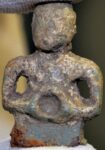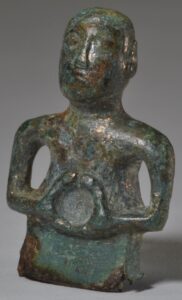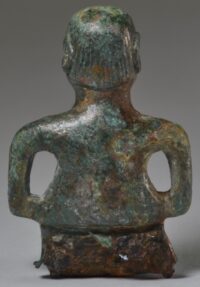A Celtic figurine discovered at the Wimpole Estate in Cambridgeshire is sporting a distinctive mullet, a possible indicator of hair styling fashion in Late Iron Age Britain. The 1st century A.D. copper alloy object is just two inches high and depicts a male figure holding a torc in his hands. He has oval eyes typical of Celtic design, a moustache and keeps his hair trimmed extra short in front, straight and long down his neck.
 The figurine was unearthed in July 2018 during the excavation of the Late Iron Age settlement at Lamp Hill. Volunteer metal detectorists scanned the excavation ditches and found the tiny mulletted man. The piece was at first believed to be a representation of the Celtic fertility god Cernunnos, but now that it has been cleaned and studied by specialists, it’s clear that he does not bear the attributes of Cernunnos. He may be a deity of unknown type with his Iron Age Billy Rae Cyrus look a distinguishing characteristic of a god with no other recorded likeness. He may also be a simple anthropomorphic figure whose hair reflects the tonsorial trends of his time.
The figurine was unearthed in July 2018 during the excavation of the Late Iron Age settlement at Lamp Hill. Volunteer metal detectorists scanned the excavation ditches and found the tiny mulletted man. The piece was at first believed to be a representation of the Celtic fertility god Cernunnos, but now that it has been cleaned and studied by specialists, it’s clear that he does not bear the attributes of Cernunnos. He may be a deity of unknown type with his Iron Age Billy Rae Cyrus look a distinguishing characteristic of a god with no other recorded likeness. He may also be a simple anthropomorphic figure whose hair reflects the tonsorial trends of his time.
It was not originally designed as a freestanding piece or cult figure. It was a decorative fitting, probably the handle of a spatula. The circular recess inside the torc probably held an inlay that is now lost.
Chris Thatcher from Oxford Archaeology East explained: “Finds such as this give a rare and fascinating insight into aesthetics and symbolism in the latest Iron Age. The extent to which his hairstyle is typical of contemporary styles will never be known for certain. However, we think the combination of him holding a torc – associated with status – and forming the handle of a spatula – either used to mix medicines, or wax for writing tablets – speak of influence and power. The fact that he was found on a site with so much other evidence for it being a local hub is wonderful and appropriate.”

